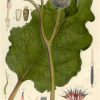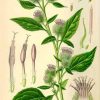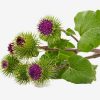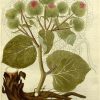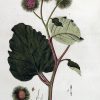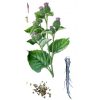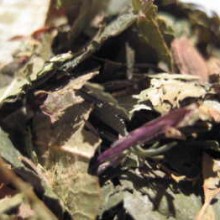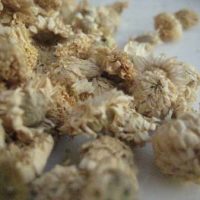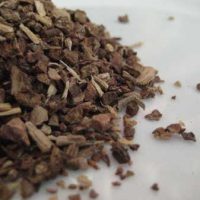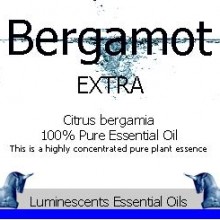Burdock Leaf which is known by many names such as Hardock, Hareburr, Turkey Burrseed, Great Burr, Cocklebur, Beggars Buttons, Cockle Buttons, Lappa, Bardane, Thorny Burr, Fox’s Clote, Love Leaves, Personata, Clotbur, Happy Major is well known for its cosmetic uses and lesser known as a medicinal herb nowdays – It was not always the case ……………..
Burdock Leaf Constituents and Uses:-
Burdock Leaf contains flavonoids and many antibacterial substances such as arctiol, fukinone and taraxasterol and are mildly laxative, mildly diuretic, and depurative in that order.
Burdock Leaf is a valuable remedy for the treatment of dry and scaly skin conditions such as psoriasis and eczema which are conditions that many people suffer badly from and bouts of which are often triggered by stress. It cleanses the blood, and should be used gently over a period of time. It may be used as part of a wider treatment for rheumatic complaints.
An infusion of Burdock Leaf may be applied to cracks, grazes, chapped skin and insect bites. It has an antimicrobial action which has been attributed to the polyacetylenes in the plant. This explains its reputation for treating toxic conditions resulting in skin eruptions such as boils; it is also useful in treating acne.
Burdock’s reaction is through bitter stimulation of the digestive juices and bile secretion and it will thus aid digestion and stimulate the appetite. It has been used in cases of anorexia nervosa and similar conditions. It can also aid kidney function. Its antimicrobial property, together with its diuretic action makes it useful for treating cystitis. Both the roots and leaves can be used to treat rheumatism and gout because they encourage the elimination of uric acid via the kidneys.
Externally it may be used as a cold compress or poultice to speed up the healing of wounds and ulcers. Eczema and psoriasis may also be managed effectively in this way.


